Online Running-Gait Generation for Bipedal Robots with Smooth State Switching and Accurate Speed Tracking
Abstract
:1. Introduction
- An online running-gait generator for bipedal robots with a VHIP model is proposed that can generate complete running motion with the smooth state switching and accurate tracking of the desired speed.
- Segmented ZMP trajectory optimization is formulated at the beginning and end of the running, which could automatically provide a feasible and smooth CoM trajectory during state switching. This allows for the robot to start or stop running stably at the given speed.
- We designed an iterative speed-guided foothold algorithm with the capturability constraint of CoM velocity during running that could accurately track the desired speed in the next two steps.
2. Running-Gait Generation with a Simplified VHIP Model
2.1. Variable-Height Inverted-Pendulum Model
2.2. Vertical CoM Generation
2.3. Horizontal CoM Computation
3. Segmented ZMP Trajectory Optimization and Speed-Guided Foothold Iterative Computation
3.1. Definition of Running State Switching
- State Switching 1: from bipedal support to cyclic single-leg support running at the beginning of running.
- State Switching 2: acceleration and deceleration during cyclic single-leg support running.
- State Switching 3: from cyclic single-leg support running to bipedal support at the end of running.
3.2. Segmented ZMP Trajectory Optimization for Smooth State Switching
3.3. Iterative Online Speed-Guided Foothold Computation
| Algorithm 1 Iterative computation for target footholds |
|
4. Results and Discussion
4.1. Robot Model and Simulation Setup
4.2. Online Running Simulation
5. Conclusions and Future Work
- For smooth state switching at the beginning and end of running, segmented ZMP trajectory optimization was proposed to automatically plan a feasible and smooth CoM trajectory that enables the robot to start or stop running stably at the given speed.
- To accurately track the online interactive commanded speed, an iterative algorithm was designed to compute the target footholds with the capturability constraint of the CoM velocity, which allowed for the robot to flexibly accelerate or decelerate online, and enhanced its reactivity.
- Lastly, combined with the proposed approaches, bipedal robot BHR7P could accomplish a complete run with variable speed through online interaction in simulation, which demonstrated the validity of these approaches.
Supplementary Materials
Author Contributions
Funding
Institutional Review Board Statement
Data Availability Statement
Conflicts of Interest
Abbreviations
| ZMP | Zero moment point |
| CoM | Center of mass |
| LIP | Linear inverted pendulum |
| VHIP | Variable-height inverted pendulum |
| TO | Trajectory optimization |
| NLP | Nonlinear programming |
| to | Take-off |
| td | touchdown |
| DoF | Degree of freedom |
References
- Kajita, S.; Kanehiro, F.; Kaneko, K.; Fujiwara, K.; Harada, K.; Yokoi, K.; Hirukawa, H. Biped walking pattern generation by using preview control of zero-moment point. In Proceedings of the 2003 IEEE International Conference on Robotics and Automation, Taipei, Taiwan, 14–19 September 2003; Volume 2, pp. 1620–1626. [Google Scholar]
- Kuindersma, S.; Deits, R.; Fallon, M.; Valenzuela, A.; Dai, H.; Permenter, F.; Koolen, T.; Marion, P.; Tedrake, R. Optimization-based locomotion planning, estimation, and control design for the atlas humanoid robot. Auton. Robots 2016, 40, 429–455. [Google Scholar] [CrossRef]
- Chen, X.; Yu, Z.; Zhang, W.; Zheng, Y.; Huang, Q.; Ming, A. Bioinspired control of walking with toe-off, heel-strike, and disturbance rejection for a biped robot. IEEE Trans. Ind. Electron. 2017, 64, 7962–7971. [Google Scholar] [CrossRef]
- Chen, B.; Zang, X.; Zhang, Y.; Gao, L.; Zhu, Y.; Zhao, J. A non-flat terrain biped gait planner based on DIRCON. Biomimetics 2022, 7, 203. [Google Scholar] [CrossRef] [PubMed]
- Di Carlo, J.; Wensing, P.M.; Katz, B.; Bledt, G.; Kim, S. Dynamic locomotion in the mit cheetah 3 through convex model-predictive control. In Proceedings of the 2018 IEEE/RSJ International Conference on Intelligent Robots and Systems (IROS), Madrid, Spain, 1–5 October 2018; pp. 1–9. [Google Scholar]
- Wang, L.; Meng, L.; Kang, R.; Liu, B.; Gu, S.; Zhang, Z.; Meng, F.; Ming, A. Design and dynamic locomotion control of quadruped robot with perception-less terrain adaptation. Cyborg Bionic Syst. 2022, 2022, 9816495. [Google Scholar] [CrossRef] [PubMed]
- Ficht, G.; Behnke, S. Bipedal humanoid hardware design: A technology review. Curr. Robot. Rep. 2021, 2, 201–210. [Google Scholar] [CrossRef]
- Mikolajczyk, T.; Mikołajewska, E.; Al-Shuka, H.F.; Malinowski, T.; Kłodowski, A.; Pimenov, D.Y.; Paczkowski, T.; Hu, F.; Giasin, K.; Mikołajewski, D.; et al. Recent advances in bipedal walking robots: Review of gait, drive, sensors and control systems. Sensors 2022, 22, 4440. [Google Scholar] [CrossRef] [PubMed]
- Nagasaki, T.; Kajita, S.; Kaneko, K.; Yokoi, K.; Tanie, K. A running experiment of humanoid biped. In Proceedings of the 2004 IEEE/RSJ International Conference on Intelligent Robots and Systems (IROS), Sendai, Japan, 28 September–2 October 2004; Volume 1, pp. 136–141. [Google Scholar]
- Tajima, R.; Honda, D.; Suga, K. Fast running experiments involving a humanoid robot. In Proceedings of the 2009 IEEE International Conference on Robotics and Automation, Kobe, Japan, 12–17 May 2009; pp. 1571–1576. [Google Scholar]
- Takenaka, T.; Matsumoto, T.; Yoshiike, T.; Shirokura, S. Real time motion generation and control for biped robot-2 nd report: Running gait pattern generation. In Proceedings of the 2009 IEEE/RSJ International Conference on Intelligent Robots and Systems, St. Louis, MO, USA, 10–15 October 2009; pp. 1092–1099. [Google Scholar]
- Egle, T.; Englsberger, J.; Ott, C. Analytical Center of Mass Trajectory Generation for Humanoid Walking and Running with Continuous Gait Transitions. In Proceedings of the 2022 IEEE-RAS 21st International Conference on Humanoid Robots (Humanoids), Ginowan, Japan, 28–30 November 2022; pp. 630–637. [Google Scholar]
- Vukobratović, M.; Borovac, B. Zero-moment point—Thirty five years of its life. Int. J. Humanoid Robot. 2004, 1, 157–173. [Google Scholar] [CrossRef]
- Dai, H.; Valenzuela, A.; Tedrake, R. Whole-body motion planning with centroidal dynamics and full kinematics. In Proceedings of the 2014 IEEE-RAS International Conference on Humanoid Robots, Madrid, Spain, 18–20 November 2014; pp. 295–302. [Google Scholar]
- Xin, S.; You, Y.; Zhou, C.; Tsagarakis, N. Humanoid running based on centroidal dynamics and heuristic foot placement. In Proceedings of the 2017 IEEE International Conference on Robotics and Biomimetics (ROBIO), Macau, Macao, 5–8 December 2017; pp. 2584–2590. [Google Scholar]
- Atlas. Partners in Parkour; Atlas: Bismarck, ND, USA, 2021. [Google Scholar]
- Sugihara, T.; Imanishi, K.; Yamamoto, T.; Caron, S. 3D biped locomotion control including seamless transition between walking and running via 3D ZMP manipulation. In Proceedings of the 2021 IEEE International Conference on Robotics and Automation (ICRA), Xi’an, China, 30 May–5 June 2021; pp. 6258–6263. [Google Scholar]
- Romualdi, G.; Dafarra, S.; L’Erario, G.; Sorrentino, I.; Traversaro, S.; Pucci, D. Online non-linear centroidal mpc for humanoid robot locomotion with step adjustment. In Proceedings of the 2022 International Conference on Robotics and Automation (ICRA), Philadelphia, PA, USA, 23–27 May 2022; pp. 10412–10419. [Google Scholar]
- Orin, D.E.; Goswami, A.; Lee, S.H. Centroidal dynamics of a humanoid robot. Auton. Robots 2013, 35, 161–176. [Google Scholar] [CrossRef]
- Mombaur, K. Using optimization to create self-stable human-like running. Robotica 2009, 27, 321–330. [Google Scholar] [CrossRef]
- Grizzle, J.W.; Hurst, J.; Morris, B.; Park, H.W.; Sreenath, K. MABEL, a new robotic bipedal walker and runner. In Proceedings of the 2009 American Control Conference, St. Louis, MO, USA, 10–12 June 2009; pp. 2030–2036. [Google Scholar]
- Schultz, G.; Mombaur, K. Modeling and optimal control of human-like running. IEEE/ASME Trans. Mechatron. 2009, 15, 783–792. [Google Scholar] [CrossRef]
- Koolen, T.; De Boer, T.; Rebula, J.; Goswami, A.; Pratt, J. Capturability-based analysis and control of legged locomotion, Part 1: Theory and application to three simple gait models. Int. J. Robot. Res. 2012, 31, 1094–1113. [Google Scholar] [CrossRef]
- Pratt, J.; Koolen, T.; De Boer, T.; Rebula, J.; Cotton, S.; Carff, J.; Johnson, M.; Neuhaus, P. Capturability-based analysis and control of legged locomotion, Part 2: Application to M2V2, a lower-body humanoid. Int. J. Robot. Res. 2012, 31, 1117–1133. [Google Scholar] [CrossRef]
- Raibert, M.H. Legged Robots That Balance; MIT Press: Cambridge, MA, USA, 1986. [Google Scholar]
- Caron, S. Biped stabilization by linear feedback of the variable-height inverted pendulum model. In Proceedings of the 2020 IEEE International Conference on Robotics and Automation (ICRA), Paris, France, 31 May–31 August 2020; pp. 9782–9788. [Google Scholar]
- Atkinson, K.E.; Han, W. Elementary Numerical Analysis; Wiley: New York, NY, USA, 1985. [Google Scholar]
- Gill, P.E.; Murray, W.; Saunders, M.A. SNOPT: An SQP algorithm for large-scale constrained optimization. SIAM Rev. 2005, 47, 99–131. [Google Scholar] [CrossRef]
- Wächter, A.; Biegler, L.T. On the implementation of an interior-point filter line-search algorithm for large-scale nonlinear programming. Math. Program. 2006, 106, 25–57. [Google Scholar] [CrossRef]
- Li, Q.; Meng, F.; Yu, Z.; Chen, X.; Huang, Q. Dynamic torso compliance control for standing and walking balance of position-controlled humanoid robots. IEEE/ASME Trans. Mechatron. 2021, 26, 679–688. [Google Scholar] [CrossRef]
- Rohmer, E.; Singh, S.P.N.; Freese, M. V-REP: A versatile and scalable robot simulation framework. In Proceedings of the 2013 IEEE/RSJ International Conference on Intelligent Robots and Systems, Tokyo, Japan, 3–7 November 2013; pp. 1321–1326. [Google Scholar]
- Dong, C.; Chen, X.; Yu, Z.; Zhang, Y.; Chen, H.; Li, Q.; Huang, Q. A unified control framework for high-dynamic motions of biped robots. In Proceedings of the 2021 6th IEEE International Conference on Advanced Robotics and Mechatronics (ICARM), Chongqing, China, 3–5 July 2021; pp. 621–626. [Google Scholar]
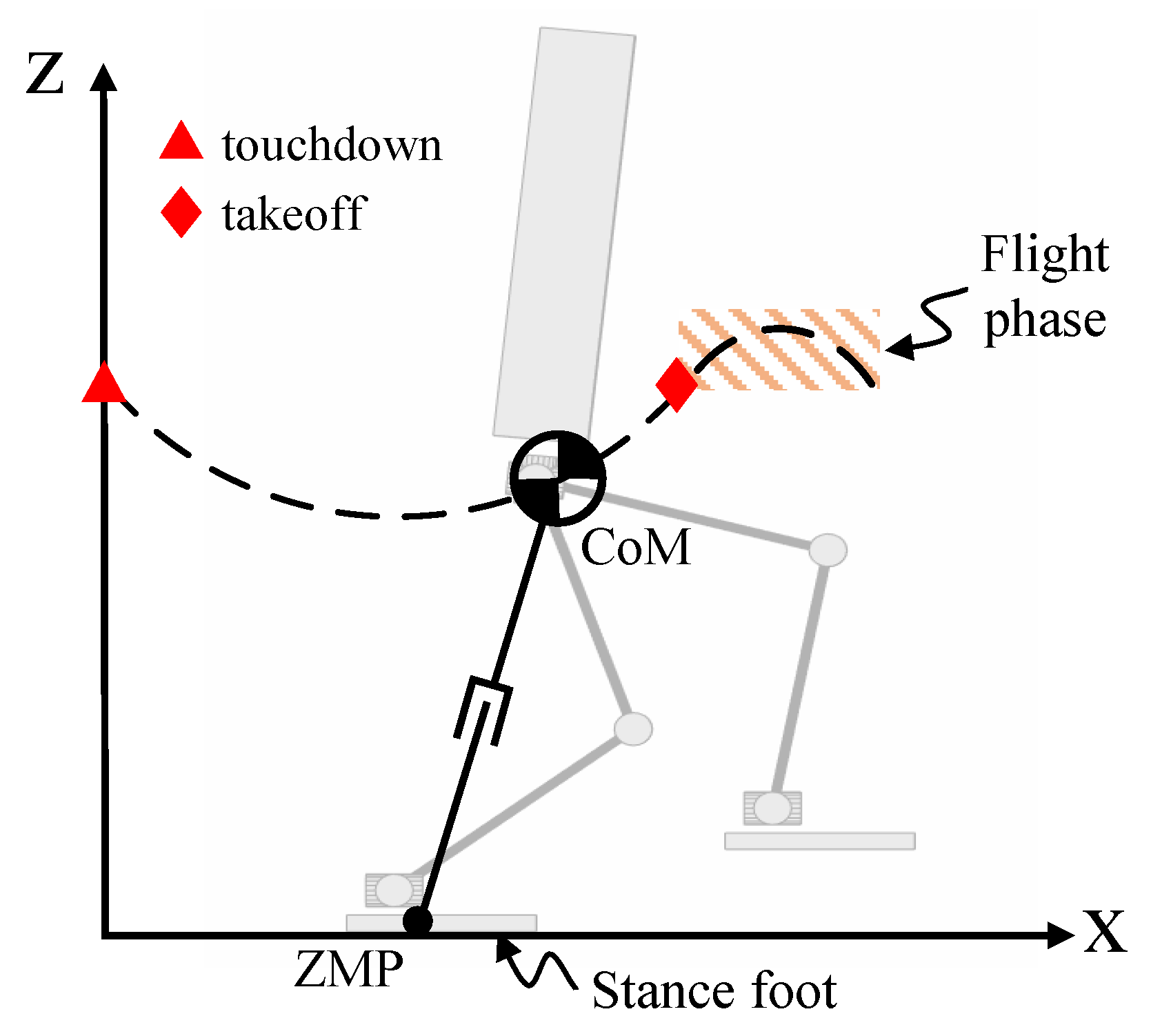
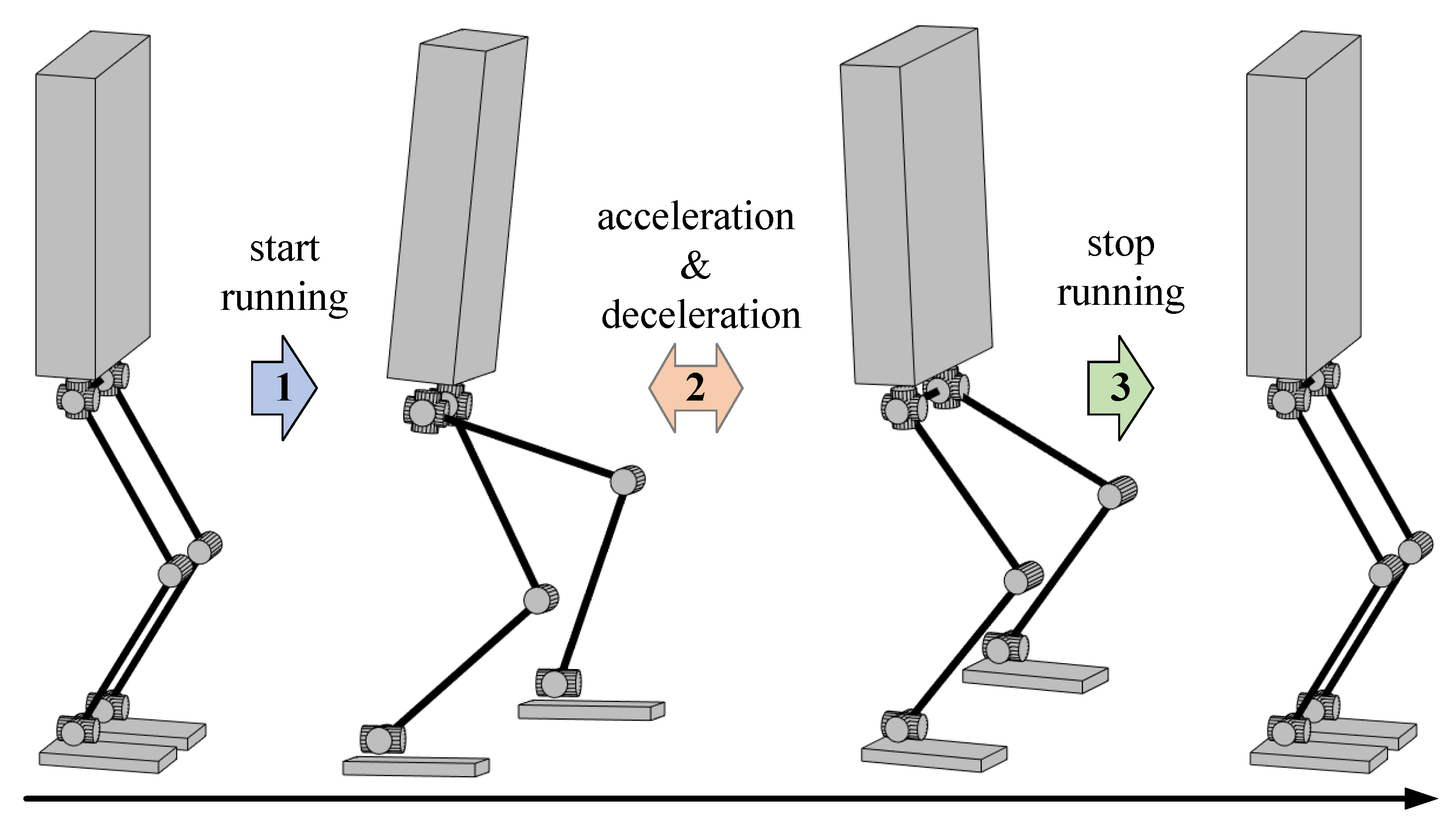

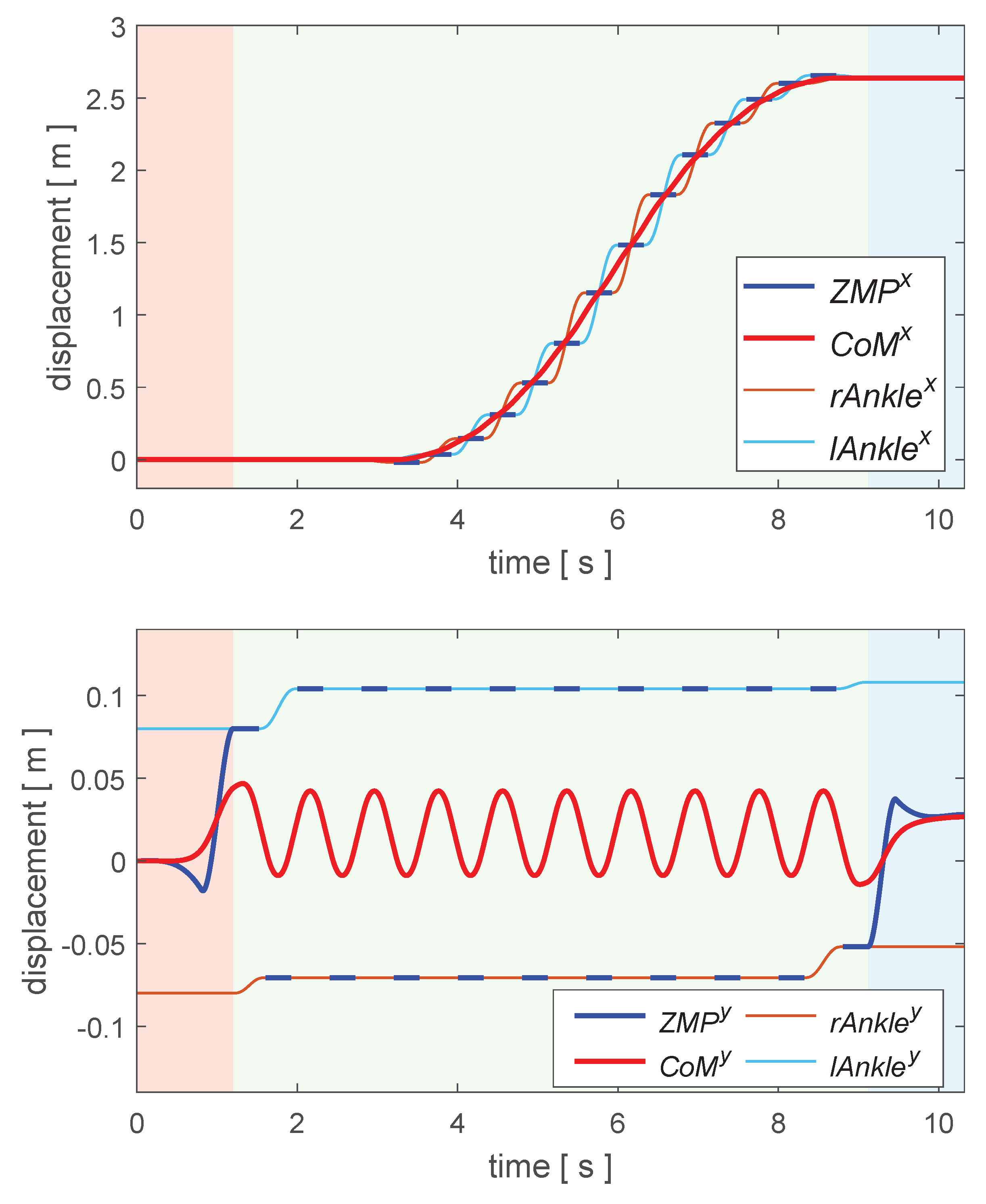
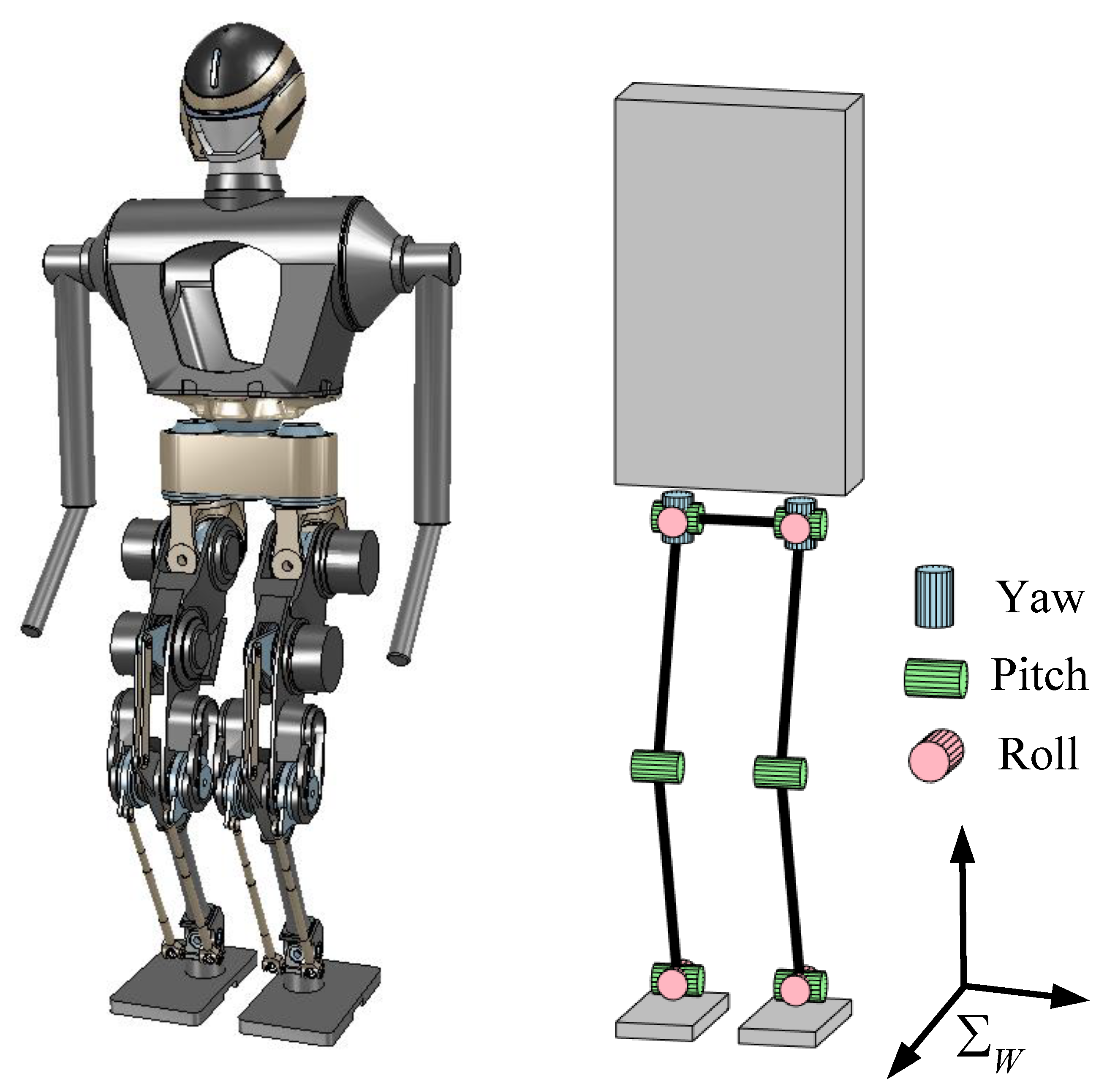
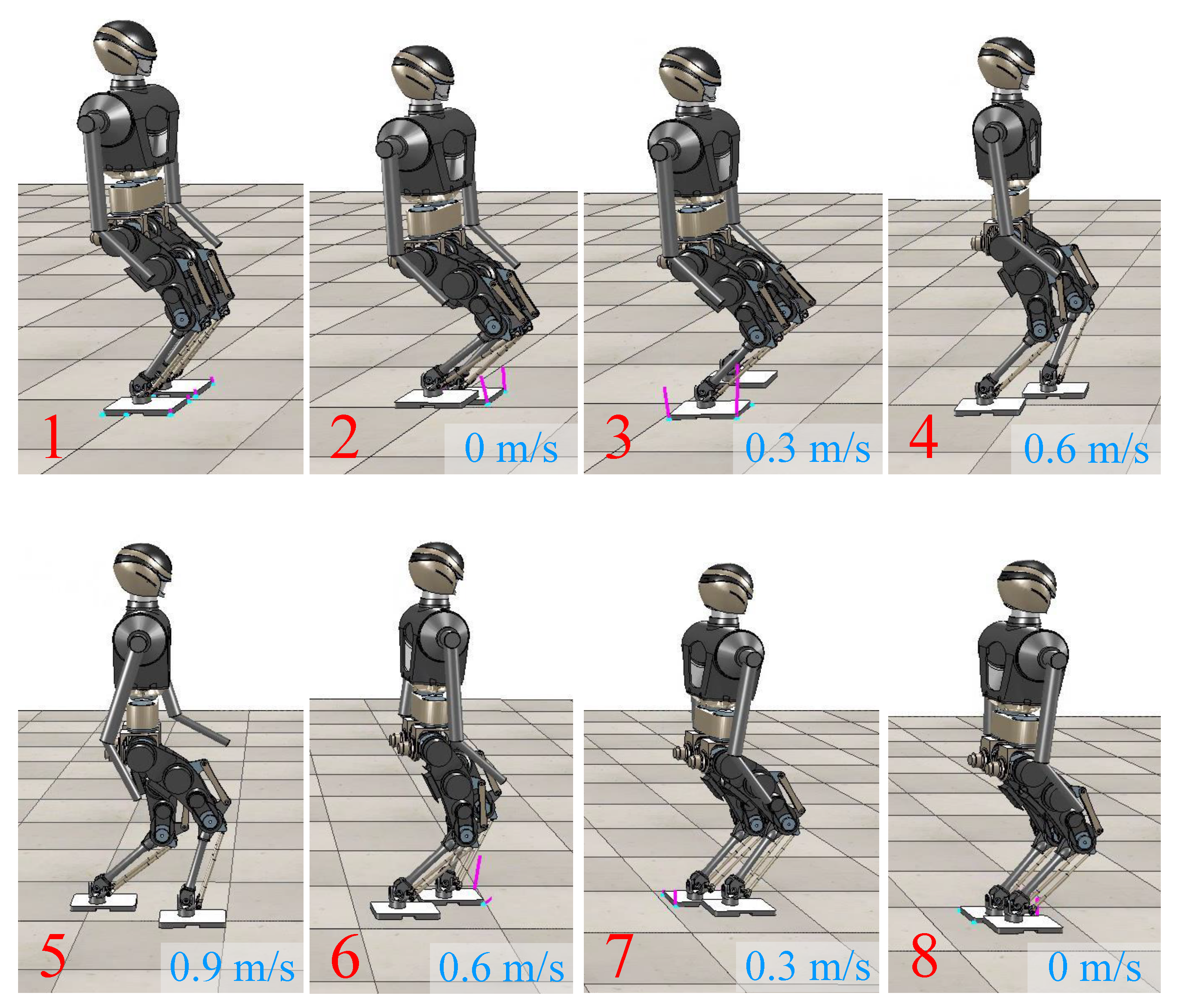
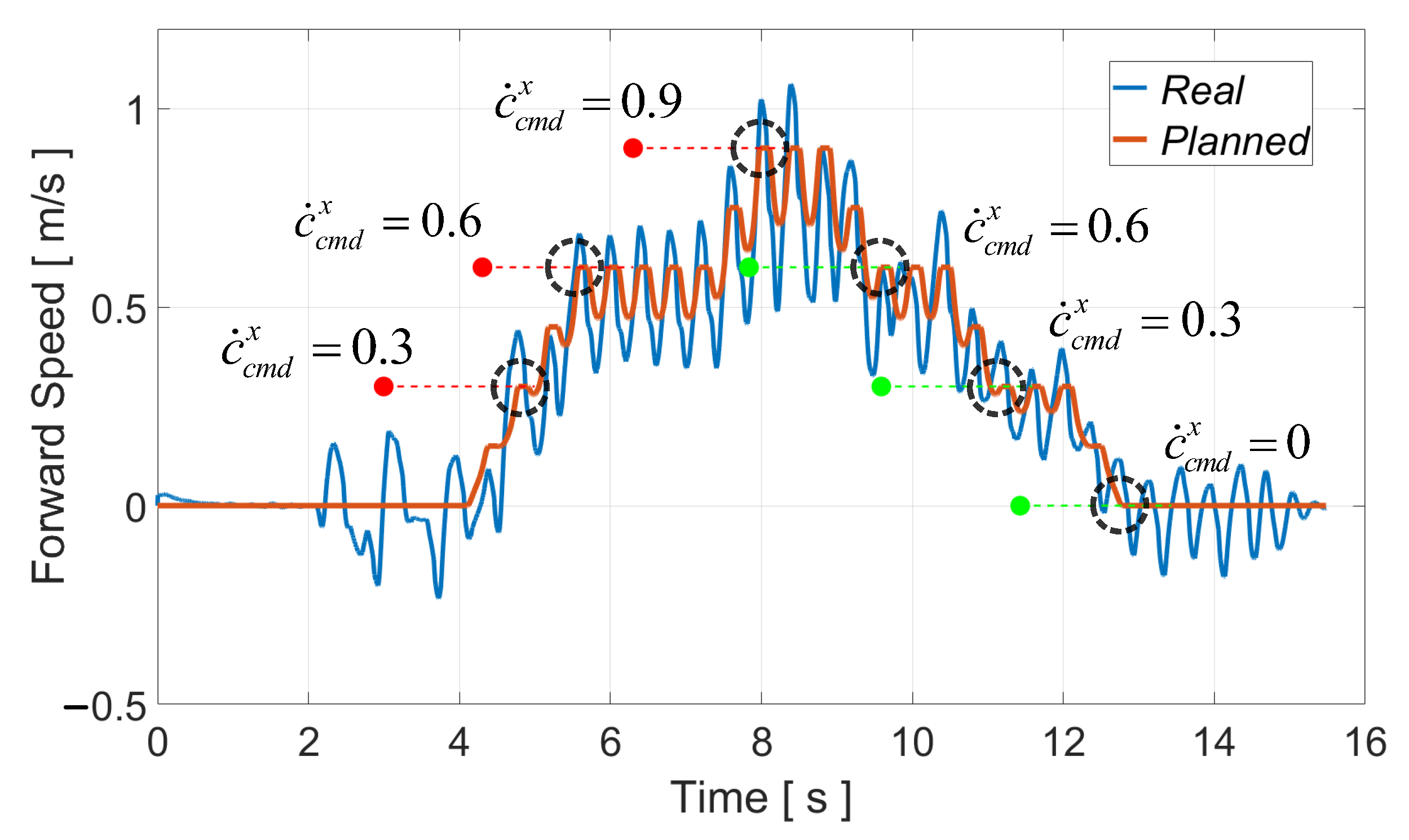
Disclaimer/Publisher’s Note: The statements, opinions and data contained in all publications are solely those of the individual author(s) and contributor(s) and not of MDPI and/or the editor(s). MDPI and/or the editor(s) disclaim responsibility for any injury to people or property resulting from any ideas, methods, instructions or products referred to in the content. |
© 2023 by the authors. Licensee MDPI, Basel, Switzerland. This article is an open access article distributed under the terms and conditions of the Creative Commons Attribution (CC BY) license (https://creativecommons.org/licenses/by/4.0/).
Share and Cite
Meng, X.; Yu, Z.; Chen, X.; Huang, Z.; Dong, C.; Meng, F. Online Running-Gait Generation for Bipedal Robots with Smooth State Switching and Accurate Speed Tracking. Biomimetics 2023, 8, 114. https://doi.org/10.3390/biomimetics8010114
Meng X, Yu Z, Chen X, Huang Z, Dong C, Meng F. Online Running-Gait Generation for Bipedal Robots with Smooth State Switching and Accurate Speed Tracking. Biomimetics. 2023; 8(1):114. https://doi.org/10.3390/biomimetics8010114
Chicago/Turabian StyleMeng, Xiang, Zhangguo Yu, Xuechao Chen, Zelin Huang, Chencheng Dong, and Fei Meng. 2023. "Online Running-Gait Generation for Bipedal Robots with Smooth State Switching and Accurate Speed Tracking" Biomimetics 8, no. 1: 114. https://doi.org/10.3390/biomimetics8010114
APA StyleMeng, X., Yu, Z., Chen, X., Huang, Z., Dong, C., & Meng, F. (2023). Online Running-Gait Generation for Bipedal Robots with Smooth State Switching and Accurate Speed Tracking. Biomimetics, 8(1), 114. https://doi.org/10.3390/biomimetics8010114





